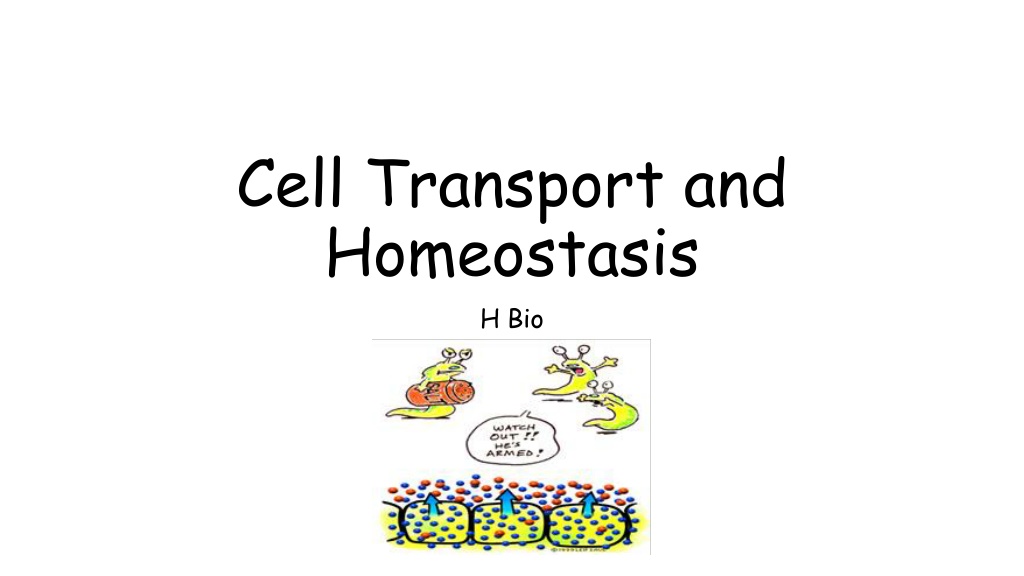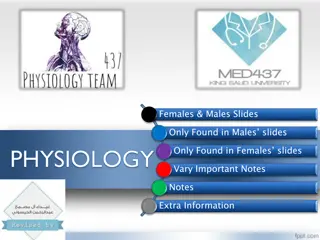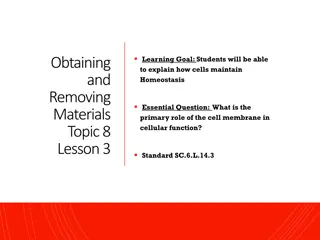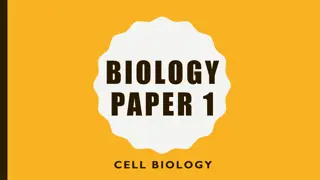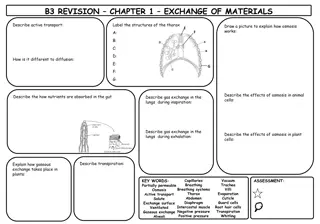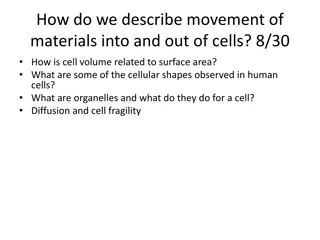Understanding Cell Transport and Homeostasis in Biology
Delve into the world of cell transport and homeostasis, exploring the functions of the cell membrane, the molecules involved, the fluid mosaic model, and passive transport mechanisms like diffusion, osmosis, and facilitated diffusion. Learn about the intricacies of maintaining equilibrium within cells.
Download Presentation

Please find below an Image/Link to download the presentation.
The content on the website is provided AS IS for your information and personal use only. It may not be sold, licensed, or shared on other websites without obtaining consent from the author. Download presentation by click this link. If you encounter any issues during the download, it is possible that the publisher has removed the file from their server.
E N D
Presentation Transcript
Cell Transport and Homeostasis H Bio
Cell Transport and the Cell Membrane Functions: Regulates what enters and leaves the cell Selectively Permeable allows only certain substances to enter and leave selects also called semi-permeable Aids in protection and support Contains and separates a cell from its environment Made of a phospholipid bilayer
Cell Transport and the Cell Membrane Molecules found in the cell membrane (biological membranes) Lipids, mainly phospholipids, animal cells also contain the steroid cholesterol to aid in membrane fluidity. Proteins (receptor, enzyme, transport/channel, carrier) Carbohydrates chains that attach to membrane proteins (glycoproteins) or lipids (glycolipids) in the cell membrane serve as name/ID tags for cell to cell recognition
Cell Transport and the Cell Membrane Fluid Mosaic Model Bilayer is fluid in nature with proteins embedded throughout Phospholipid Bilayer Contain a hydrophilic head and a nonpolar hydrophobic tail H bonds form between the phospholipids head and the watery environment inside and outside of the cell Hydrophobic interactions force the tails to face inward Phospholipids are not bonded to each other, making the layer fluid Cholesterol embedded in the membrane makes is stronger and less fluid
Cell Transport and the Cell Membrane Passive Transport down a concentration gradient, no E Diffusion Osmosis Facilitated Diffusion
7.3 Cell Transport A) Passive Transport no energy required molecules from H L concentration * across a semi-permeable membrane until equilibrium is reached ex) FACILITATED DIFFUSION: use of protein channels (diffusion w/help) * to move charged molecules or large items move in/out * still from H L concentration (no energy needed) * ex) glucose, certain ions * ex) diffusion of water (OSMOSIS) thru semi-permeable membrane Different solution environments: HYPERTONIC = solution is high (hyper = above) in solute (ex: salt water) HYPOTONIC = solution is low (hypo = below) in solute (ex: fresh water) ISOTONIC = solution is a equilibrium with outside environment ex) DIFFUSION: movement of 1 2 3
The Effect of Osmosis on Cells Cell shrinking = plasmolysis Cell swelling and bursting = cytolysis
Cell Transport and the Cell Membrane Active Transport up/against gradient, required E (ATP) Membrane/Molecular Pumps Bulk Transport Endocytosis Exocytosis
B) Active Transport energy needed to move items from LH concentration (against/up the concentration gradient) ex) molecular : small molecules and ions - moved through special protein channels - nerve cells use the Na/K pump (33% of all our energy!) ex) bulk: for very large items - requires cell membrane to change shape a) endocytosis cell membrane folds inward, brings item in * phagocytosis (cell eating) used by amoeba and WBC s * pinocytosis (cell drinking): packets of fluid brought inside cell b) exocytosis materials are released from the cell * vacuole fuses with membrane, contents released to outside * ex: hormones made in brain pituitary released to bloodstream travel to target organ
Homeostasis and Levels of Organization: Unicellular ONE cell is the entire organism (ex: bacteria, protists) - internal cell environment is regulated by the whole cell Multicellular cells depend on jobs of other cells to regulate internal environment - cells need to be specialized in certain functions - cells must have ways of communicating with each other Cell Communication: - chemical signals picked up by receptors on target cell (ex: hormones) - cell to cell connections (gap junctions) passageways for contents to share Levels of Organization: from simplest to most complex cell tissue organ organ system organism
